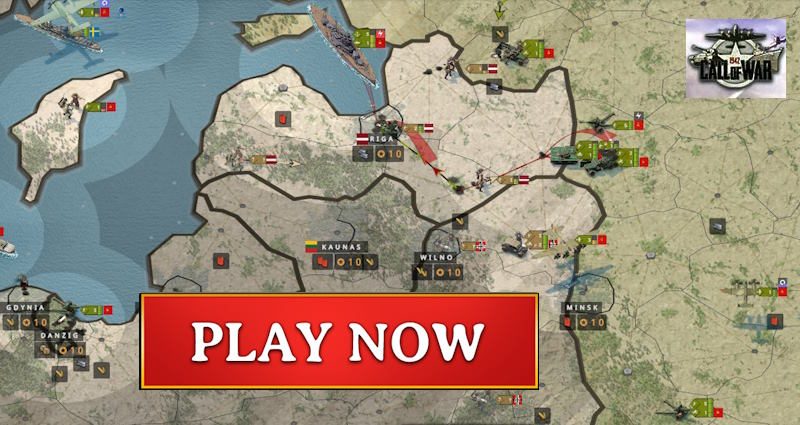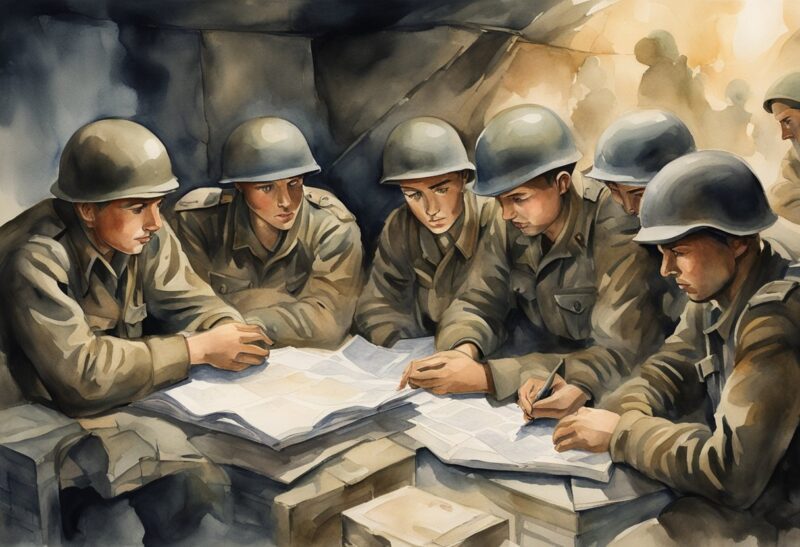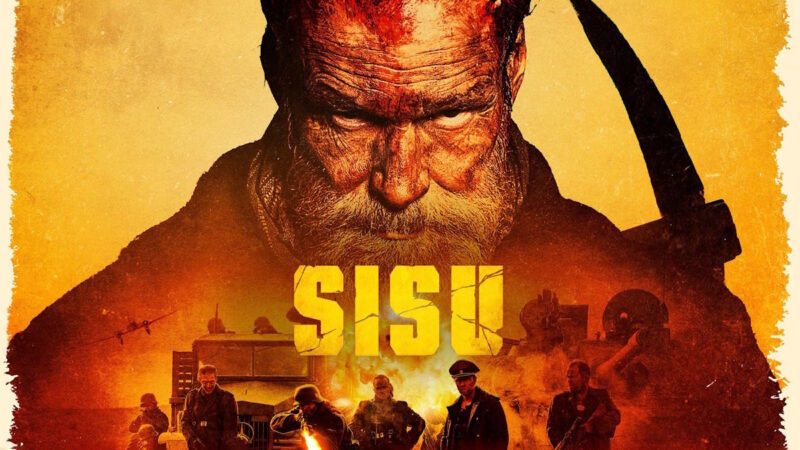Clint Eastwood Iwo Jima films: Flags of Our Fathers vs Letters from Iwo Jima – My Take on These Twin Masterpieces.
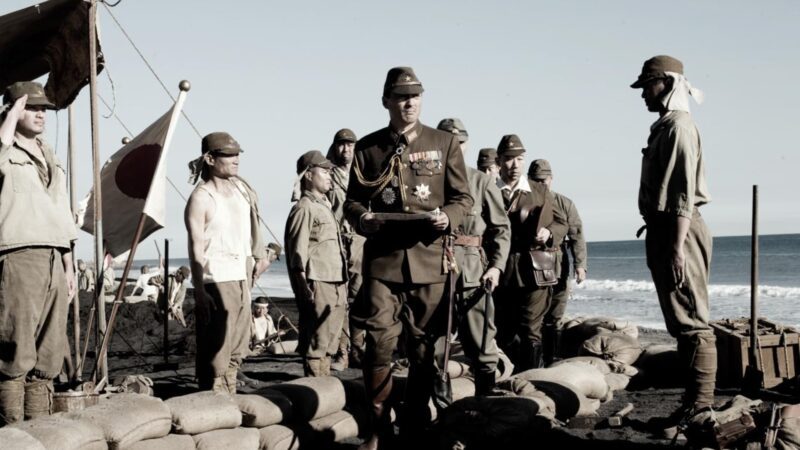
‚Flags of Our Fathers‘ and ‚Letters from Iwo Jima‘ from Clint Eastwood
Table of Contents
As a movie buff, I’ve always been fascinated by Clint Eastwood’s unique approach to storytelling. His two films about the Battle of Iwo Jima – “Flags of Our Fathers” and “Letters from Iwo Jima” – really caught my attention. These movies give us a rare chance to see both sides of a major World War II battle.
We think Eastwood’s decision to make two companion films about Iwo Jima was a stroke of genius. “Flags of Our Fathers” shows us the American view, while “Letters from Iwo Jima” puts us in the shoes of the Japanese soldiers. It’s not often we get to see a director tackle the same event from such different angles.
What I find most interesting is how these films challenge our ideas about war and patriotism. They don’t just show us the heroics – they also reveal the human cost of battle and the complex emotions of the soldiers on both sides. Eastwood’s compassionate approach makes these movies stand out from typical war films.
Biography of Clint Eastwood
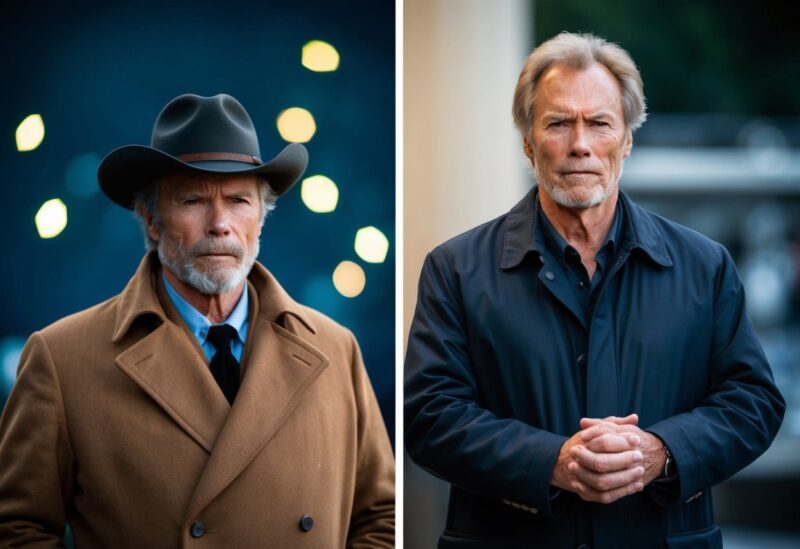
Clint Eastwood is a Hollywood legend known for his acting and directing. He’s had a long career spanning many decades and genres.
Career as a Director
Clint started directing in the 1970s. His first film was “Play Misty for Me” in 1971. He quickly made a name for himself behind the camera. Some of his best-known early films are “The Outlaw Josey Wales” and “Unforgiven.”
Clint has a unique style as a director. He often explores themes of morality and masculinity. His films tend to be gritty and realistic. He’s known for working quickly and efficiently on set.
In recent years, Clint has focused more on directing than acting. He’s tackled a wide range of subjects, from war films to biopics.
Eastwood’s Filmography
Clint’s filmography is huge. As an actor, he’s best known for Westerns and action movies. Some of his iconic roles include:
- The Man with No Name in Sergio Leone’s “Dollars Trilogy”
- Dirty Harry in the “Dirty Harry” series
- Walt Kowalski in “Gran Torino”
As a director, Clint has made over 30 films. Here are some of his most famous:
- “Unforgiven” (1992)
- “Million Dollar Baby” (2004)
- “Gran Torino” (2008)
- “American Sniper” (2014)
Clint has won many awards for his work. He’s got four Academy Awards and four Golden Globes. His films often get praise from critics and do well at the box office.
Historical Context of the Iwo Jima Battles
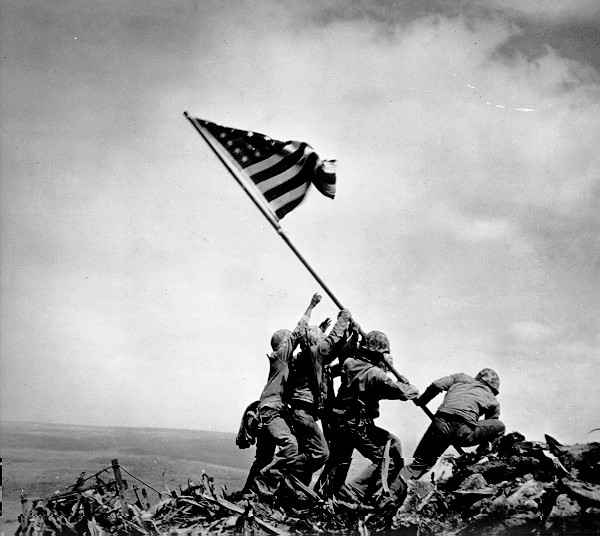
The Battle of Iwo Jima was a key moment in World War II. It took place in 1945 and saw U.S. Marines face off against Japanese soldiers. We’ll look at why this tiny island was so important and who played big roles in the fight.
The Strategic Importance of Iwo Jima
Iwo Jima may have been small, but it was a big deal. The U.S. wanted it as a base for planes attacking Japan. It was also a spot where Japanese fighters could warn the mainland about incoming U.S. bombers.
The island had airfields that both sides wanted to control. For the U.S., taking Iwo Jima meant safer air raids on Japan. It also gave damaged U.S. planes a place to land on the way back from missions.
We can’t forget how tough the terrain was. The island’s black sand and many caves made it perfect for defense. This made the battle even harder for U.S. troops.
Pivotal Figures in the Battle
General Tadamichi Kuribayashi led the Japanese forces on Iwo Jima. He was smart and did things differently than other Japanese commanders. Instead of fighting on the beaches, he had his men dig deep into the island.
On the U.S. side, we had leaders like General Holland Smith. He was in charge of all the Marines in the Pacific. There were also brave soldiers like John Basilone, who won medals for his actions.
We can’t forget the regular troops either. U.S. Marines fought hard to take the island inch by inch. Japanese soldiers followed orders to fight to the death, making the battle very fierce.
Analyzing ‘Flags of Our Fathers’
We found “Flags of Our Fathers” to be a complex and thought-provoking film. It digs into themes of heroism and patriotism while showing the human cost of war. Let’s take a closer look at what makes this movie tick.
Narrative and Themes
The movie tells the story of the famous Iwo Jima flag-raising photo. We see how it impacts the lives of the soldiers involved. The film jumps between different time periods, which can be a bit confusing at first. But it helps show how the past affects the present.
We really liked how it questions what makes a hero. The movie shows that the real heroes aren’t always the ones in the spotlight. It also looks at how the government uses war heroes for propaganda. This made us think about how we view patriotism today.
Casting and Characters
Ryan Phillippe and Adam Beach stand out in the cast. They bring depth to their roles as John “Doc” Bradley and Ira Hayes. We felt Beach’s portrayal of Hayes was especially moving. He shows the struggles of a Native American soldier facing racism and guilt.
The film doesn’t shy away from showing the flaws of its characters. This made them feel more real to us. We could see bits of ourselves in their doubts and fears.
Cinematographic Style
Eastwood’s style in this film is gritty and realistic. The battle scenes are intense and chaotic. We felt like we were right there with the soldiers. The color palette is muted, which adds to the somber tone.
We noticed how the camera often focuses on small details. A hand touching sand, a tear on a cheek. These moments add emotional weight to the bigger picture.
Historical Accuracy and Reception
The movie sticks pretty close to the real events. It’s based on a book by James Bradley, son of one of the flag-raisers. We appreciated how it shows both the heroism and the messy reality of war.
Critics mostly liked the film. It has a 73% rating on Rotten Tomatoes. Some people felt it was a bit slow or hard to follow. But many praised its honesty about war. The Academy noticed too, giving it Oscar nominations for Sound Editing and Sound Mixing.
Analyzing ‘Letters from Iwo Jima’
We found “Letters from Iwo Jima” to be a deeply moving and insightful film. It gave us a new perspective on a well-known battle by showing the Japanese side.
Story from the Japanese Perspective
The movie follows General Tadamichi Kuribayashi and his troops as they defend Iwo Jima. We see their struggles, fears, and hopes. The film shows us that the Japanese soldiers were human, just like their American foes.
We felt the weight of their impossible task. They knew they would likely die, but fought on anyway. The movie doesn’t shy away from showing the harsh realities of war.
We appreciated how the film explored themes of duty, honor, and sacrifice. It made us think about what we might do in their shoes.
Casting and Characters
Ken Watanabe shines as General Kuribayashi. We felt his inner conflict between duty and compassion. Kazunari Ninomiya also gives a strong performance as a young soldier.
The cast brings depth to their roles. We saw the characters as real people, not just enemies. This helped us connect with their stories on a personal level.
We liked how the film showed different types of Japanese soldiers. Some were kind, others cruel. It avoided making them all the same.
Cinematic Techniques
The film’s look matches its somber tone. We noticed the muted colors and dark scenes. This choice helped us feel the soldiers’ grim situation.
Clint Eastwood’s direction is subtle but powerful. We felt like we were there in the tunnels with the soldiers. The battle scenes are intense without being over-the-top.
We liked how the movie used letters to tell the story. It gave us insight into the characters’ thoughts and feelings.
Critical Acclaim and Awards
“Letters from Iwo Jima” got lots of praise from critics. It has a high score on Rotten Tomatoes. We can see why – it’s a powerful and unique war film.
The movie won several awards, including an Oscar for Best Sound Editing. It was also up for Best Picture, which is rare for a foreign language film.
Comparative Analysis of Both Films
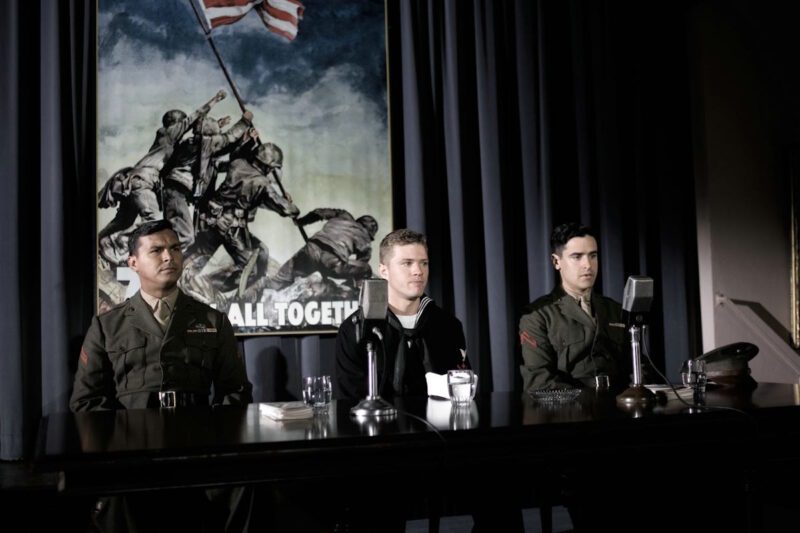
We found Clint Eastwood’s Iwo Jima films to be a fascinating look at the same battle from two very different angles. Let’s break down how these movies compare.
Narratives and Storytelling Approaches
In “Flags of Our Fathers,” we follow the American soldiers who raised the flag on Mount Suribachi. The story jumps between the battle and their experiences back home as reluctant heroes.
“Letters from Iwo Jima” gives us the Japanese side. It focuses on soldiers like Private Saigo, showing their fears and doubts as they face certain defeat.
We appreciated how Eastwood used different storytelling styles for each film. The American story felt more fragmented, mirroring the chaos of war and fame. The Japanese tale was more linear, building tension as the battle approached.
Differing Perspectives on Heroism
The films made us think about heroism in different ways. “Flags” questions what makes a hero, showing how the flag-raisers struggled with being called heroes for what they saw as just doing their job.
“Letters” presents Japanese soldiers as humans, not just enemies. We see their bravery in the face of hopeless odds. The film asks us to consider heroism on both sides of a conflict.
Both movies challenge the idea of glory in war. They show the heavy toll of battle on all soldiers, regardless of which side they’re on.
Cinematography and Battle Scenes
The battle scenes in both films left a big impact on us. In “Flags,” we’re thrown into the chaos of the beach landing. The camera shakes and moves with the soldiers, making us feel like we’re right there with them.
“Letters” uses a more muted color palette, giving a somber tone to the Japanese defense. The cave scenes are claustrophobic and tense.
We noticed Eastwood used different techniques to show the brutality of war in each film. “Flags” has more graphic violence, while “Letters” relies more on implied horror and psychological tension.
Public and Critical Reception
We found it interesting how these films were received. “Letters from Iwo Jima” got more critical praise, winning several awards. Many critics called it a masterpiece.
“Flags of Our Fathers” had a more mixed reception. Some loved its complex take on heroism, while others found it confusing.
Both films did well internationally. Japanese audiences praised “Letters” for its respectful portrayal of their soldiers.
We think the two films work best when viewed together. They give a fuller picture of the battle and its impact on both sides.
Influence on Cinema and Culture
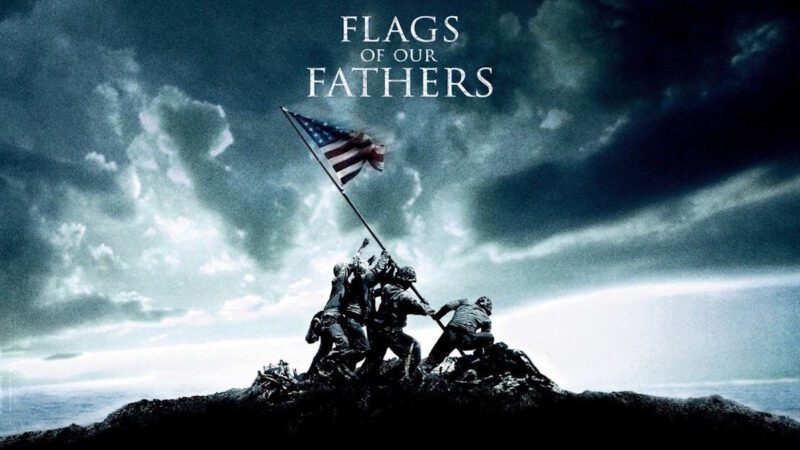
Clint Eastwood’s Iwo Jima films changed how we see war movies. They made us think about both sides of battle in new ways. We felt the impact on screens big and small.
Impact on War Film Genre
Eastwood’s two-movie approach was groundbreaking. We’ve never seen a director tackle the same battle from opposing viewpoints before. It reminded us of “Saving Private Ryan,” but with a fresh twist.
The films pushed us to rethink how war stories are told. They showed the human side of soldiers on both sides. This wasn’t just about American heroes anymore.
We saw a shift in war movies after these came out. More films started looking at different angles of conflict. It wasn’t all action and glory – we got to see the messy, emotional parts too.
Reflection of Societal Attitudes
These movies came out when we were thinking hard about war. They hit close to home for many of us.
We saw ourselves reflected in the doubt and fear of the soldiers. The films made us question what it means to be a hero. They showed how war stories can be used – and misused – by those in power.
The movies sparked talks about how we remember war. We started looking closer at old documentaries like “To the Shores of Iwo Jima” and “Heroes of Iwo Jima.” We wondered if they told the whole story.
Eastwood’s work pushed us to seek out more voices and viewpoints in history. It wasn’t just about winning or losing anymore. We wanted to understand all sides of the story.
Legacy and Concluding Remarks
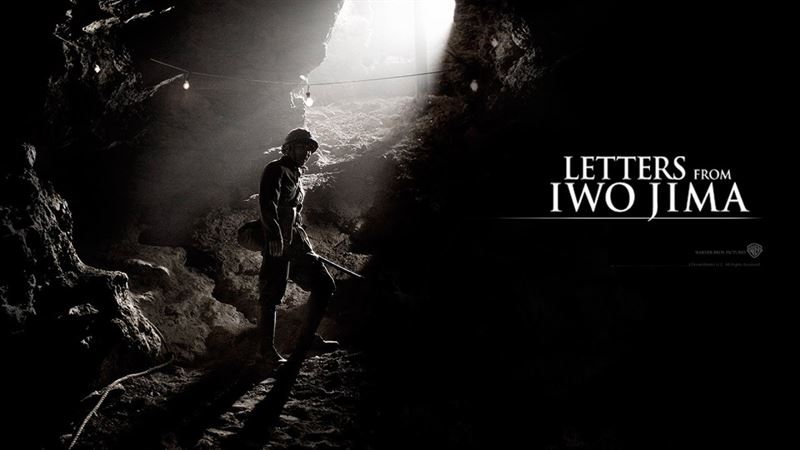
We think Clint Eastwood’s Iwo Jima films left a big mark on war movies. “Flags of Our Fathers” and “Letters from Iwo Jima” showed the battle from both sides. This was new and exciting.
The movies made us think about war in a different way. They didn’t just show heroes. They showed real people dealing with tough stuff.
We loved how Eastwood paid attention to details. He tried hard to get things right about the battle and the time period. This made the films feel very real to us.
Ryan Phillippe’s acting in “Flags of Our Fathers” really stood out. He helped bring the story of the flag-raisers to life.
These films changed how we see war movies. They showed that war stories can be complex and thoughtful. We think they’ll be remembered for a long time.
The “Heroes of Iwo Jima” documentary came out around the same time. It added even more to what we learned from Eastwood’s films.
We believe these movies will keep teaching people about Iwo Jima for years to come. They remind us that there are many sides to every story.
Frequently Asked Questions
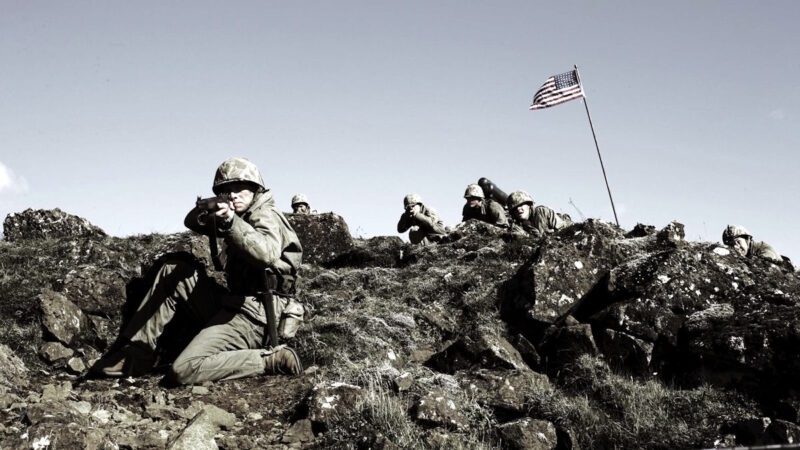
We get a lot of questions about Clint Eastwood’s Iwo Jima films. Here are answers to some common ones we hear.
How historically accurate are the depictions in ‘Flags of Our Fathers’?
‘Flags of Our Fathers’ stays pretty true to history. We think Eastwood did a good job showing what really happened. He talked to real Iwo Jima veterans to get the details right.
The famous flag-raising scene looks just like the real photo. The movie also shows how the government used that image to raise money for the war effort.
What are the major differences between ‘Flags of Our Fathers’ and ‘Letters from Iwo Jima’?
The main difference is the point of view. ‘Flags’ shows the American side, while ‘Letters’ tells the Japanese story. ‘Flags’ focuses more on what happened after the battle. ‘Letters’ spends more time on the fighting itself.
We noticed ‘Letters’ feels more personal. It digs into the Japanese soldiers’ lives and thoughts. ‘Flags’ is broader, looking at both the battle and its impact back home.
Should ‘Flags of Our Fathers’ be watched before ‘Letters from Iwo Jima’ or vice versa?
We don’t think there’s a right or wrong order. You can enjoy each movie on its own. Watching them back-to-back can be cool, though. It lets you see both sides of the story at once.
Some of us like starting with ‘Flags’ since it came out first. Others prefer ‘Letters’ because it follows the timeline of the battle more closely.
What controversies surround the film ‘Letters from Iwo Jima’?
Some people weren’t happy that an American director made a movie about Japanese soldiers. They worried it might not be fair or accurate. But most critics praised Eastwood for trying to understand both sides.
A few Japanese viewers felt the movie didn’t show enough of their culture. But many liked how it portrayed their soldiers as real people, not just enemies.
Is ‘Letters from Iwo Jima’ available on streaming platforms like Netflix?
As of January 2025, ‘Letters from Iwo Jima’ isn’t on Netflix. But streaming rights change often. We’ve seen it pop up on different platforms over the years.
Your best bet is to check movie rental services or buy a digital copy. Some libraries also have DVDs you can borrow.

Which film provides the most comprehensive view of the Battle of Iwo Jima?
We think watching both movies gives you the fullest picture. Each one shows things the other doesn’t. ‘Flags’ covers more of the battle’s impact on America. ‘Letters’ digs deeper into what happened on the island.
If you only have time for one, ‘Letters’ might give a bit more detail about the actual fighting. But ‘Flags’ helps you understand why Iwo Jima became such a big deal in U.S. history.


